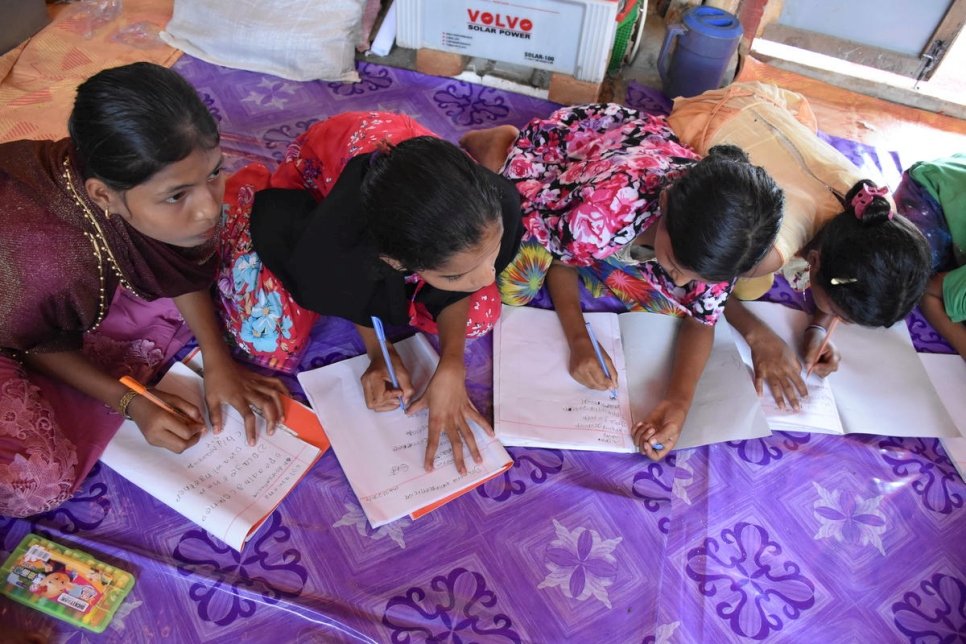By Mubaraq Olayinka Ganiyu, PACS, University of Manitoba
Date: October 22, 2025
Behind
the Fences: Why Rohingya Girls Are Still Denied Education
A Generation Without Classrooms
In
the world’s largest refugee settlement, education is more than just a right
it’s a fragile lifeline. In the refugee camps of Cox’s Bazar, Bangladesh, young
Rohingya girls wake each day with little chance of attending school. Displaced
from their homes and denied basic rights, their hopes of learning fade behind
makeshift fences and cultural walls.
Since
2017, over 700,000 Rohingya refugees have fled targeted violence in Myanmar.
Today, more than a million reside in Bangladesh. Over half are children
vulnerable, traumatized, and in desperate need of support. Education, which
should provide safety and opportunity, remains painfully out of reach for many
of them especially for girls.
This
article looks at the education crisis facing Rohingya girls in the camps,
exploring both formal and non-formal learning systems, the gender-specific
barriers they face, and what can be done to create better futures for this
forgotten generation.
Life in Limbo: The Roots of the Rohingya Refugee Crisis
The
story of Rohingya displacement is rooted in decades of systemic discrimination
in Myanmar. Since independence, Rohingya Muslims have been excluded from
citizenship and legal recognition². While persecution has a long history, the
crisis escalated in 2017 when Myanmar’s military launched a brutal campaign of
killings, sexual violence, and mass displacement in Rakhine State forcing
hundreds of thousands to flee across the border into Bangladesh³.
Today,
these families live in overcrowded refugee camps with limited access to health,
mobility, livelihoods and education.
Where Are the Schools?
There
are approximately 3,400 Temporary Learning Centres (TLCs) in the camps with
UNICEF supporting more than 2,800 of them⁴. These centers provide informal
learning for about 300,000 Rohingya children⁵. But the gaps are still immense:
- 16% of children
aged 3–14
receive no education at all
- 81% of adolescents
aged 15–24
are entirely out of school⁴
These
numbers are more than statistics they reflect lives derailed. Without
education, refugee children are more vulnerable to child labor, early marriage,
trafficking, and radicalization⁶. Families, often unable to work legally, rely
on children to contribute income pushing many out of classrooms and into
hardship¹.
What’s the Difference? Formal vs. Non-Formal Education
Formal
education
takes place in recognized schools, follows an approved curriculum, and leads to
academic certification. It is essential for preparing children for higher
education, employment, and reintegration into society⁷.
Non-formal
education
is less structured typically delivered through community centers or workshops
focusing on life skills, literacy, and vocational training. It’s flexible and
often better suited for children who have faced trauma or interrupted
schooling⁸.
Currently,
only non-formal education is offered in the Rohingya camps. While it
provides valuable learning and emotional support, the lack of official
certification means it is often viewed as temporary or less useful especially
by parents hoping for real opportunities for their children⁹.
Still,
both types are vital. As shown in similar refugee contexts like Uganda, formal
education helps with social inclusion, while non-formal education
boosts employability and emotional well-being¹⁰.
Why Are Rohingya Girls Dropping Out?
While
boys and girls attend TLCs in similar numbers at early ages, the gender gap
widens sharply during adolescence. Several overlapping barriers prevent girls
from continuing their education:
- Cultural and
religious norms:
Girls are often expected to help with housework and stay home after
puberty¹¹.
- Safety concerns: Families fear
harassment or violence, making parents reluctant to let daughters leave
home. These fears are not unfounded sexual abuse has been reported from
community members, camp officials, and even within families¹² ¹³.
- Early marriage: With little hope
for the future, many families marry girls off young, believing it will
keep them safe or reduce household burdens¹⁰ ¹⁴.
- Lack of female
teachers:
The shortage of women educators makes parents uncomfortable with sending
girls to school especially teens⁴.
These
factors contribute to high dropout rates, isolating girls from education,
social networks, and protection from exploitation.
More Than Just Classrooms: The Bigger Obstacles
Beyond
gender-specific issues, several broader challenges affect all Rohingya
children:
- No recognized
curriculum:
Non-formal programs currently used are not certified, leaving students
with no official academic standing¹.
- Language barriers: Many children
speak only Rohingya or Bangla, while lessons are often in Burmese⁸.
- Underqualified
teachers:
Educators are often community volunteers with little training. Physical
punishment has also been reported⁶.
- Lack of
infrastructure:
Overcrowded, under-resourced TLCs make for poor learning environments,
lacking proper sanitation or safe spaces.
What Can Be Done?
Despite
the challenges, meaningful change is possible. Here are key recommendations:
- Roll out the
Myanmar Curriculum Pilot (MCP): Launched by UNICEF and
partners in 2020, this program uses the official Myanmar curriculum giving
students a chance at recognized education, especially if repatriation ever
becomes possible⁴.
- Expand non-formal
learning programs:
Offer more life-skills education, vocational training, and flexible
learning options for adolescents and young adults who are out of school¹.
- Address gender
barriers:
Hire more female teachers and develop safe learning environments.
Community engagement is crucial to shifting harmful norms around girls’
education¹¹.
- Improve teacher
training and child protection: Educators need to be trained
in trauma-informed approaches, classroom management, and safeguarding to
ensure learning environments are both safe and effective.
Hope Beyond the Camps
The
education crisis in the Rohingya camps is not only a humanitarian
emergency it is a test of our commitment
to justice and human dignity. Denying children an education today will lock
them into cycles of poverty, dependence, and marginalization for generations to
come.
Yet,
with focused investment, community-led approaches, and international support,
education can be a powerful tool for recovery, empowerment, and long-term
peacebuilding. We must act not only to teach Rohingya children but to show them
that they matter.
Want to help? Support organizations working directly with Rohingya refugees like UNICEF, BRAC, or Save the Children. Share their stories, advocate for inclusive policies, and don’t let this crisis fall off the world’s radar.
References
- Hossain, 2023
- Johnson, 2019
- UNHCR, 2022
- UNICEF, 2022
- ReliefWeb, 2022
- Rahman et al., 2023
- UNESCO, 2020
- Shohel, 2022
- Habib et al., 2023
- Melnikas et al.,
2020
- Islam et al., 2021
- Haar et al., 2019
- Akhter &
Kusakabe, 2014
- Uddin, 2021
.



